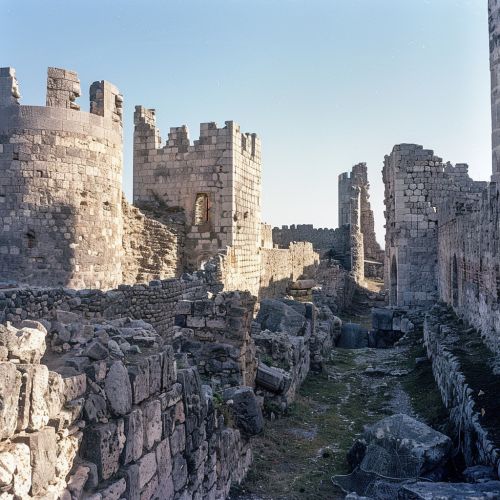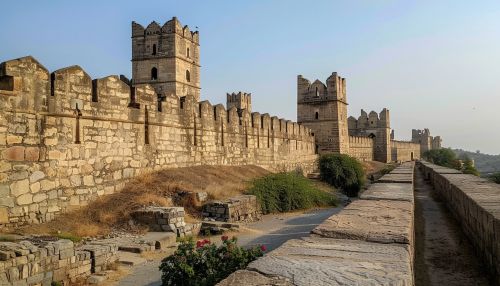The Citadel: Difference between revisions
(Created page with "== Overview == The Citadel, often referred to as a fortress or stronghold, is a core element in the architecture and defense systems of ancient and medieval cities. It serves as the last line of defense, a place of refuge, and a symbol of power and authority. The term "citadel" is derived from the Latin word "civitas," meaning "city," and it typically refers to a fortified area within a city or town. == Historical Significance == Citadels have played a crucial role th...") |
No edit summary |
||
| Line 15: | Line 15: | ||
During the medieval period, citadels became more sophisticated in their design and construction. The [[Tower of London]], for instance, was built by William the Conqueror in the 11th century and served as a royal residence, prison, and fortress. The [[Kremlin]] in Moscow, another notable example, has been the seat of Russian power for centuries and contains numerous palaces, cathedrals, and government buildings. | During the medieval period, citadels became more sophisticated in their design and construction. The [[Tower of London]], for instance, was built by William the Conqueror in the 11th century and served as a royal residence, prison, and fortress. The [[Kremlin]] in Moscow, another notable example, has been the seat of Russian power for centuries and contains numerous palaces, cathedrals, and government buildings. | ||
[[Image:Detail-92567.jpg|thumb|center|An ancient stone citadel with high walls and towers, surrounded by a moat.|class=only_on_mobile]] | |||
[[Image:Detail-92568.jpg|thumb|center|An ancient stone citadel with high walls and towers, surrounded by a moat.|class=only_on_desktop]] | |||
== Architectural Features == | == Architectural Features == | ||
Latest revision as of 22:53, 17 June 2024
Overview
The Citadel, often referred to as a fortress or stronghold, is a core element in the architecture and defense systems of ancient and medieval cities. It serves as the last line of defense, a place of refuge, and a symbol of power and authority. The term "citadel" is derived from the Latin word "civitas," meaning "city," and it typically refers to a fortified area within a city or town.
Historical Significance
Citadels have played a crucial role throughout history, particularly in ancient and medieval times. They were constructed to protect the inhabitants from invaders and to serve as a command center during sieges. The design and construction of citadels varied significantly depending on the geographical location, available materials, and the specific needs of the inhabitants.
Ancient Citadels
In ancient civilizations, citadels were often the heart of the city. For example, the Acropolis in Athens served as a religious and administrative center, as well as a defensive stronghold. Similarly, the Citadel of Aleppo in Syria, one of the oldest and largest citadels in the world, dates back to the 3rd millennium BC and has been used by various civilizations, including the Greeks, Romans, Byzantines, and Ottomans.
Medieval Citadels
During the medieval period, citadels became more sophisticated in their design and construction. The Tower of London, for instance, was built by William the Conqueror in the 11th century and served as a royal residence, prison, and fortress. The Kremlin in Moscow, another notable example, has been the seat of Russian power for centuries and contains numerous palaces, cathedrals, and government buildings.


Architectural Features
Citadels are characterized by their robust construction and strategic location. They are typically built on elevated ground to provide a vantage point over the surrounding area. Key architectural features of citadels include:
Walls and Towers
The walls of a citadel are usually thick and high, designed to withstand attacks from siege engines and artillery. Towers are often integrated into the walls to provide additional defensive capabilities and to serve as lookout points. The Alhambra in Spain, for example, features impressive walls and towers that have withstood numerous sieges over the centuries.
Gates and Entrances
The entrances to citadels are heavily fortified and often include multiple gates, drawbridges, and portcullises. These features are designed to slow down and control the movement of attackers. The Bab al-Yemen in Sana'a, Yemen, is a prime example of a fortified gate that has protected the city for centuries.
Inner Structures
Within the walls of a citadel, there are usually various buildings and structures, including barracks, armories, and granaries. These facilities ensure that the defenders have the necessary resources to withstand a prolonged siege. The Red Fort in Delhi, India, contains numerous palaces, halls, and gardens, showcasing the architectural and cultural achievements of the Mughal Empire.
Military Strategy and Tactics
Citadels played a crucial role in military strategy and tactics. They served as command centers where military leaders could coordinate their defenses and plan counterattacks. The elevated position of citadels allowed defenders to observe enemy movements and deploy their forces effectively.
Siege Warfare
Siege warfare was a common tactic used to capture citadels. Attackers would surround the citadel, cutting off supplies and reinforcements, and use various siege engines, such as battering rams, trebuchets, and siege towers, to breach the walls. The defenders, on the other hand, would use their elevated position to launch counterattacks and repel the invaders.
Defensive Innovations
Over time, various defensive innovations were developed to enhance the effectiveness of citadels. These included the use of concentric walls, moats, and bastions. The Château de Vincennes in France, for example, features a series of concentric walls and a deep moat, making it one of the most formidable fortresses of its time.
Cultural and Symbolic Importance
Beyond their military function, citadels often held significant cultural and symbolic importance. They were seen as symbols of power and authority, representing the strength and stability of the ruling class. Many citadels also served as administrative and religious centers, housing important government buildings, temples, and palaces.
Symbol of Power
The imposing presence of a citadel served as a constant reminder of the ruling authority's power and control. The Edinburgh Castle in Scotland, perched atop a volcanic rock, dominates the city's skyline and has been a symbol of Scottish power for centuries.
Cultural Heritage
Many citadels are now recognized as important cultural heritage sites and have been preserved for their historical and architectural significance. The Citadel of Erbil in Iraq, for example, is one of the oldest continuously inhabited sites in the world and has been designated a UNESCO World Heritage Site.
Modern Relevance
While the military importance of citadels has diminished with the advent of modern warfare, they continue to hold cultural and historical significance. Many citadels have been converted into museums, tourist attractions, and cultural centers, allowing visitors to explore and appreciate their historical legacy.
Preservation and Restoration
Efforts to preserve and restore citadels are ongoing around the world. These projects aim to protect the architectural integrity of the structures while making them accessible to the public. The restoration of the Citadel of Qaitbay in Alexandria, Egypt, for example, has helped to preserve this important historical site for future generations.
Educational Value
Citadels also serve as valuable educational resources, providing insights into the history, architecture, and military strategies of past civilizations. They offer a tangible connection to the past, allowing people to learn about and appreciate the achievements and challenges of earlier societies.
